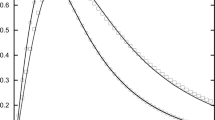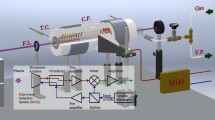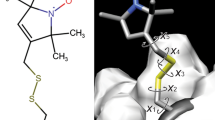Abstract
The electron paramagnetic resonance (EPR) signal of gaseous nitric oxide (NO) has been measured by continuous wave X-band experiments at room temperature at gas pressures between 1 mbar and 60 mbar and at a gas pressure of 48 mbar at different low temperatures. A phenomenological spin Hamiltonian approach allows simulating each EPR signal of NO by changing only a single line width parameter. At room temperature, this line width depends linearly on the NO gas pressure which can be explained by kinetic gas theory. An effective collisional cross section has been determined by this way which is about twice as large as the known cross section for NO derived from viscosity measurements. Experiments with NO gas at low temperatures are consistent to the line width interpretation by kinetic theory. In total, the results demonstrate that in NO adsorption and desorption experiments at different temperatures and NO gas pressures below 60 mbar the amount of desorbed NO can simply be determined in situ by the line width of this signal, which one can obtain easily from a conventional simulation procedure.







Similar content being viewed by others
References
M. Chiesa, E. Giamello, M. Che, Chem. Rev. 110, 1320 (2009). doi:10.1021/cr800366v
A. Baldansuren, R.-A. Eichel, E. Roduner, Phys. Chem. Chem. Phys. 11, 6664 (2009). doi:10.1039/B903870A
C. Pal, P.S. Wheatley, H.E. Mkami, D.J. Keeble, R.E. Morris, O. Schiemann, Appl. Magn. Reson. 37, 619–627 (2010). doi:10.1007/s00723-009-0071-x
P. Pietrzyk, K. Podolska, Z. Sojka, J. Phys. Chem. C 115, 13008 (2011). doi:10.1021/jp203188k
P. Pietrzyk, C. Dujardin, K. Gora-Marek, P. Granger, Z. Sojka, Phys. Chem. Chem. Phys. 14, 2203 (2012). doi:10.1039/C1CP23038G
B. Barth, M. Mendt, A. Pöppl, M. Hartmann, Micropor. Mesopor. Mat. (2015). doi:10.1016/j.micromeso.2015.02.020
A.C. McKinlay, B. Xiao, D.S. Wragg, P.S. Wheatley, I.L. Megson, R.E. Morris, J. Am. Chem. Soc. 130, 10440 (2008). doi:10.1021/ja801997r
R. Beringer, J. Castle, Phys. Rev. 78, 581 (1950). doi:10.1103/PhysRev.78.581
M. Jinguji, Y. Ohokubo, I. Tanaka, Chem. Phys. Lett. 54, 136 (1978). doi:10.1016/0009-2614(78)85683-8
F. Bonino, S. Chavan, J.G. Vitillo, E. Groppo, G. Agostini, C. Lamberti, P.D.C. Dietzel, C. Prestipino, S. Bordiga, Chem. Mater. 20, 4957 (2008). doi:10.1021/cm800686k
M.A. Newton, B. Jyoti, A.J. Dent, S.G. Fiddy, J. Evans, Chem. Commun., 2382 (2004) doi: 10.1039/B405694A
T. Rudolf, A. Pöppl, W. Brunner, D. Michel, Magn. Reson. Chem. 37, S93 (1999). doi:10.1002/(SICI)1097-458X(199912)37:13<S93:AID-MRC565>3.0.CO;2-E
T. Rudolf, W. Böhlmann, A. Pöppl, J. Magn. Reson. 155, 45 (2002). doi:10.1006/jmre.2002.2504
A.A. Westenberg, N. deHaas. J. Chem. Phys. 51, 5215 (1969). doi:10.1063/1.1671935
M. Ruzzi, E. Sartori, A. Moscatelli, I.V. Khudyakov, N.J. Turro, J. Phys. Chem. A 117, 5232 (2013). doi:10.1021/jp403648d
T.J. Cook, T.A. Miller, J. Chem. Phys. 59, 1352 (1973). doi:10.1063/1.1680190
S. Stoll, A. Schweiger, J. Magn. Reson. 178, 42 (2006). doi:10.1016/j.jmr.2005.08.013
G.R. Hanson, K.E. Gates, C.J. Noble, M. Griffin, A. Mitchell, S. Benson, Contributions from the 11th International Conference on Biological Inorganic Chemistry 98, 903 (2004) doi: 10.1016/j.jinorgbio.2004.02.003
G. Herzberg, J.W.T. Spinks, Spectra of Diatomic Molecules (D. Van Nostrand Company, New York [etc.], 1950)
T.C. James, R.J. Thibault, J. Chem. Phys. 41, 2806 (1964). doi:10.1063/1.1726356
M. Mizushima, Phys. Rev. 94, 569 (1954)
R. Beringer, E.B. Rawson, A.F. Henry, Phys. Rev. 94, 343 (1954). doi:10.1103/PhysRev.94.343
R.L. Brown, H.E. Radford, Phys. Rev. 147, 6 (1966). doi:10.1103/PhysRev.147.6
J.H. van Vleck, Rev. Mod. Phys. 23, 213 (1951)
H. Margenau, A. Henry, Phys. Rev. 78, 587 (1950). doi:10.1103/PhysRev.78.587
C.C. Lin, M. Mizushima, Phys. Rev. 100, 1726 (1955). doi:10.1103/PhysRev.100.1726
G. Dousmanis, Phys. Rev. 97, 967 (1955). doi:10.1103/PhysRev.97.967
J.A. Weil, J.R. Bolton, Electron Paramagnetic Resonance: Elementary Theory and Practical Applications, 2nd edn. (Wiley-Interscience, Hoboken, N.J., 2007)
E.L. Hill, Phys. Rev. 34, 1507 (1929)
S. Stoll, Dissertation (ETH Zürich, 2003)
H. Bauer, K.F. Sahm, J. Chem. Phys. 42, 3400 (1965). doi:10.1063/1.1695741
J.O. Hirschfelder, C.F. Curtiss, R.B. Bird, Molecular Theory of Gases and Liquids (Wiley, New York, London, 1954)
C.J. Jameson, A.K. Jameson, J.K. Hwang, J. Chem. Phys. 94, 172 (1991). doi:10.1063/1.460375
C.J. Jameson, A.K. Jameson, J.K. Hwang, J. Chem. Phys. 89, 4074 (1988). doi:10.1063/1.454842
F.M. Chen, R.F. Snider, J. Chem. Phys. 46, 3937 (1967). doi:10.1063/1.1840467
W.V. Smith, R. Howard, Phys. Rev. 79, 132 (1950). doi:10.1103/PhysRev.79.132
L.D. Landau, E.M. Lifshits, L.P. Pitaevskiĭ, J.B. Sykes, M.J. Kearsley, Statistical Physics, 3rd edn. (Elsevier Butterworth Heinemann, Amsterdam, London, 1980)
C. Gerthsen, D. Meschede, Gerthsen Physik, 24th edn. (Springer, Berlin [u.a.], 2010)
C.J. Ultee, J. Chem. Phys. 54, 5437 (1971). doi:10.1063/1.1674854
T.J. Cook, T.A. Miller, J. Chem. Phys. 59, 1342 (1973). doi:10.1063/1.1680189
W.E. Köhler, Z. Naturforsch. 29a, 1705 (1974)
C. Wang, W. Tomlinson, Phys. Rev. 181, 115 (1969). doi:10.1103/PhysRev.181.115
A. Gallagher, Phys. Rev. 157, 68 (1967). doi:10.1103/PhysRev.157.68
Acknowledgments
The financial support of this work by the Deutsche Forschungsgemeinschaft (DFG) in the frame of its priority program SPP 1362 is gratefully acknowledged.
Author information
Authors and Affiliations
Corresponding author
Rights and permissions
About this article
Cite this article
Mendt, M., Pöppl, A. The Line Width of the EPR Signal of Gaseous Nitric Oxide as Determined by Pressure and Temperature-Dependent X-band Continuous Wave Measurements. Appl Magn Reson 46, 1249–1263 (2015). https://doi.org/10.1007/s00723-015-0714-z
Received:
Revised:
Published:
Issue Date:
DOI: https://doi.org/10.1007/s00723-015-0714-z




